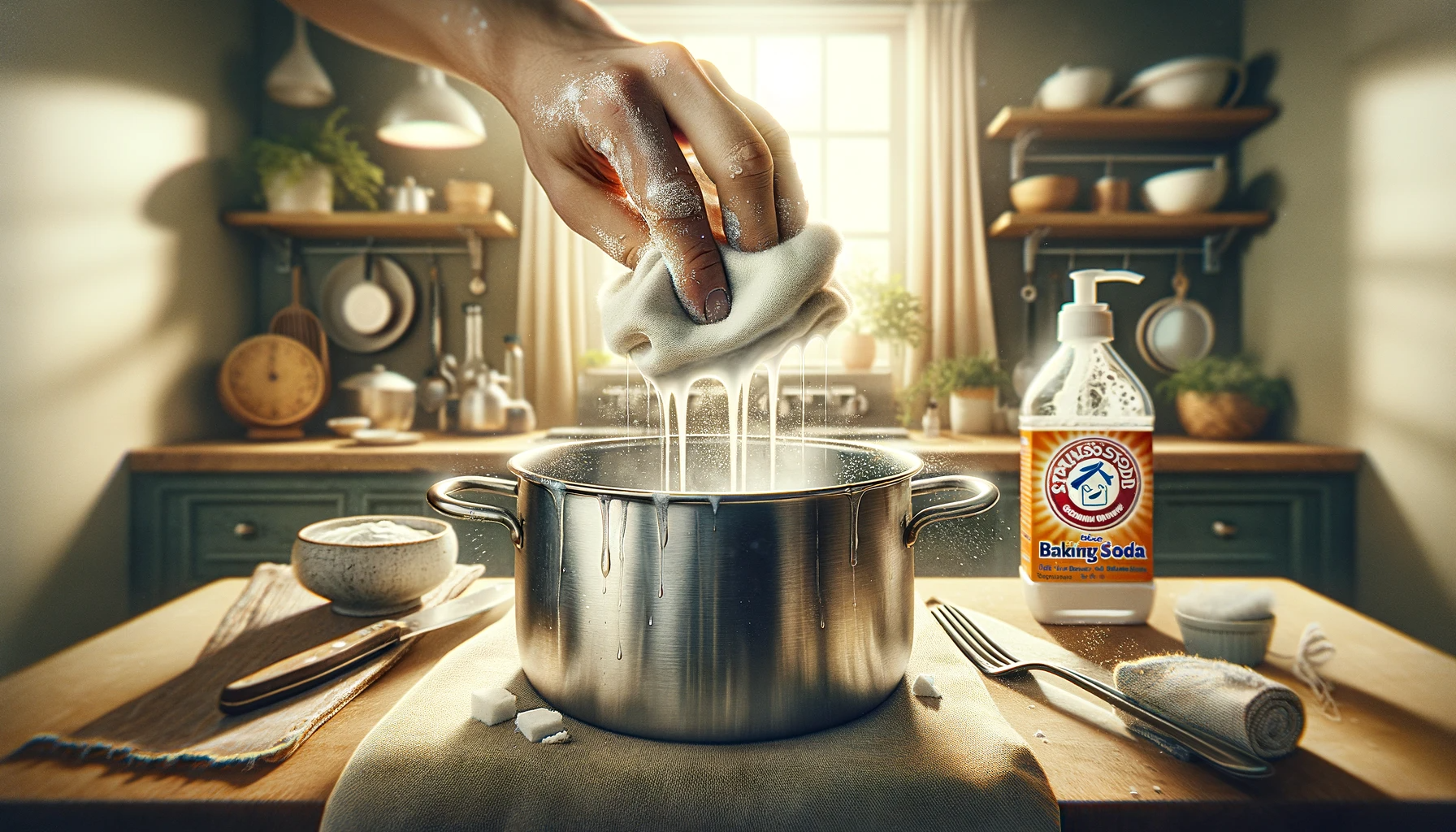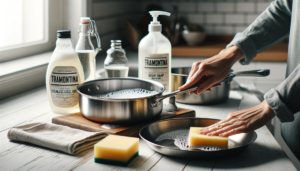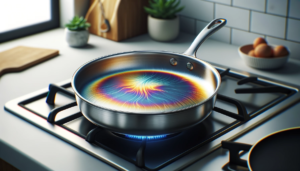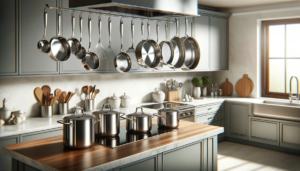If your stainless steel pots emerge from the dishwasher still looking grungy or you notice food sticking to your favorite skillet that won’t budge no matter how much you scrub, it’s time to bring in the big guns – baking soda.
Creating an easy baking soda paste and letting it work its magic delivers a non-abrasive, affordable cleaner that removes the toughest residue from well-loved stainless steel cookware while maintaining its integrity.
Let’s dive in to how baking soda can tackle the cleaning woes of even the most neglected stainless steel pan…
How to Clean Stainless Steel Cookware with Sodium Bicarbonate?

To clean stainless steel cookware using sodium bicarbonate properly, make a thick paste by mixing together baking soda with a bit of water.
Apply this directly to the interior surface of pots, pans, and skillets where grime and residue have built up.
Let the paste sit and penetrate before scrubbing with a damp soft cloth or sponge.
Be sure to rinse and immediately dry with a towel to prevent water spots.
This baking soda cleaning method is safe, effective, and gentle enough for even the most delicate cookware.
Read on below for a more expansive walkthrough on tackling stainless steel’s toughest cooked-on messes using items likely already in your kitchen.
Why Use Baking Soda to Clean Stainless Steel Cookware

Baking soda is an excellent cleaning agent for stainless steel pots, pans, and other cookware for several key reasons.
One, because baking soda is a gentle abrasive, it can help lift burned and cooked-on reside without damaging the stainless steel surface like harsher cleaning products might.
Two, baking soda is effective at absorbing and neutralizing odors that can linger in cookware if food residue isn’t properly removed.
Lastly, baking soda is inexpensive and can be found in any grocery store.
Since stainless steel is prone to corrosion over time, especially when exposed to salt and acid from cooking, it’s important to clean it thoroughly yet gently on a regular basis.
A baking soda paste helps remove that residue before it has time to break down the stainless steel itself while also protecting the cookware’s appearance by getting rid of staining or discoloration.
Compared to steel wool or abrasive cleaners that can scratch stainless steel surfaces, baking soda offers a safe cleaning option.
Overall, baking soda is an affordable, accessible, and effective cleaning solution for stainless steel pots and pans used for all types of cooking.
It tackles leftover grease, food build up, odor, and stains without damaging the cookware.
What You Need

Cleaning stainless steel pots and pans with baking soda does not require many supplies, which is another advantage over some commercial cleaners that call for several ingredients.
To make a baking soda paste for cleaning stainless steel cookware, you just need a few basic items:
Baking Soda
The key ingredient is of course baking soda, also known as sodium bicarbonate.
Make sure you have at least a half cup on hand so there is enough to cover the interior surface area of the cookware you want to clean.
Any typical baking soda that you use for cooking or baking will work perfectly.
Water
You will mix a bit of water with the baking soda to form a spreadable paste.
Warm water can help dissolve the baking soda more quickly, but cool water will also get the job done.
Avoid extremely hot water though that could produce fumes.
Have a bowl and spoon ready to stir the water and baking soda together.
Clean Sponge or Soft Cloth
Choose a sponge or lint-free cloth that will not scratch the stainless steel surface when scrubbing the baking soda paste.
Soft microfiber cloths are ideal, but a washed sponge with no abrasive side can work as well.
Have this ready before applying the paste.
Stainless Steel Cookware
Finally, pull out the stainless steel pots, pans, or other items that require cleaning.
Focus on cookware used most often where residue likely accumulates, especially if you notice staining, stickiness, or odors.
The baking soda can tackle all types of stainless steel cookware used for various cooking applications.
As long as you have baking soda, water, a gentle scrubbing tool, and dirty stainless steel cookware on hand, you can move on to making the cleaning paste.
Making a Baking Soda Paste

Whipping up a simple baking soda paste takes just minutes before getting started on cleaning stainless steel cookware by hand.
Here is the process:
Add Baking Soda to a Bowl
Start by measuring out the baking soda, using at least 1/2 cup as mentioned previously.
Pour this into a medium bowl, allowing enough room to mix the paste.
Stir in Just Enough Water to Form a Paste
Next, slowly drizzle small amounts of water from a glass into the bowl while stirring constantly.
Use a spoon or spatula to mix thoroughly after each pour.
Consistency Should Allow Spreading But Remain Thick
Continue adding tiny splashes of water and mixing until a grainy paste forms with a thickness similar to peanut butter.
The paste should be loose enough to spread across surfaces, but not runny so it drips off.
Finding the right consistency might take some trial and error when making a baking soda paste.
But the paste can always be adjusted by adding a tiny bit more water if too dry or a touch more baking soda if overly wet.
Use Immediately or Store Covered
For best cleaning results, use the fresh baking soda paste right away after mixing.
However, the unused paste can be covered and stored at room temperature to finish cleaning the stainless steel cookware later.
Now that the baking soda cleaning paste is ready to go, it’s time to start the scrubbing process.
Applying an even layer of the baking soda paste is key to letting it fully penetrate and lift baked-on food bits without damaging the stainless steel.
Here are application tips:
Spread Paste Over Entire Interior Surface
Use the soft sponge or cloth to apply the paste across the full inside of pots, pans, and other cookware needing cleaning.
Cover not just visible stains but the entire surface area.
Pay Extra Attention to Cooked-On Spots
Check for darker or stickier areas where food residue remains stuck to the stainless steel.
Apply extra paste to these spots, pressing down firmly with the sponge or cloth to help it penetrate.
Let Paste Sit for Several Minutes
After completely coating the interior of cookware with paste, let it sit for 2 to 5 minutes.
This pause allows the baking soda solution time to start breaking down remaining food build-up.
Apply More Paste to Heavily Soiled Areas
Reapply another layer of paste to extra dirty spots visible after the sitting period, if needed.
Top it off until fully covered again.
Once baked-on food has softened and lifting residue is noticeable from the bubbling paste, it’s time to start gently scrubbing.
Scrubbing the Paste
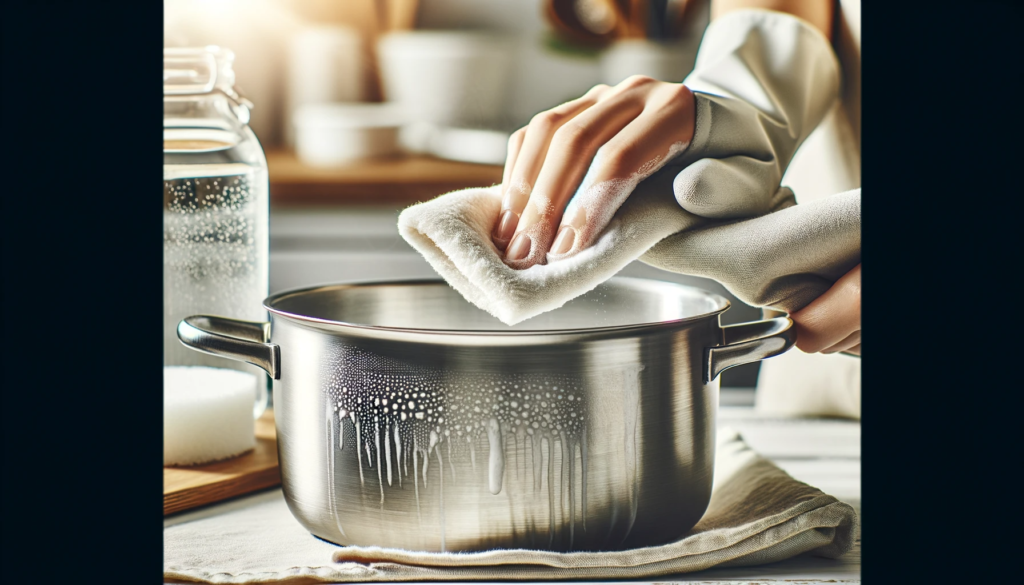
Light scrubbing with a soft sponge or cloth is recommended after letting the baking soda paste sit.
Here is how to complete this important step:
Use a Damp Sponge or Soft Cloth
Wet your chosen scrubbing tool in clean water and wring thoroughly so it remains just slightly damp.
This helps activate the baking soda paste.
Gently Scrub Stained Areas
Apply light pressure while scrubbing those darker or stuck-on areas where the paste is actively fizzing and lifting food build-up.
Let the baking soda paste do the work.
Avoid Abrasive Scrubbers or Brushes
As a reminder, anything that could scratch or damage the stainless steel surface must be avoided.
So no steel wool, rough brushes, or abrasive sponge sides.
Rinse Paste Residue Frequently While Scrubbing
Pause scrubbing occasionally to rinse away paste residue under running water.
This clears both the loosened food particles and enables you to visibly check cleaning progress.
Continue scrubbing the entire interior surface with the baking soda paste until the stainless steel again looks shiny and free of residue.
Rinsing and Drying

After thoroughly scrubbing stainless steel cookware with the baking soda paste, the final steps are:
Rinse All Paste Off with Warm Water
Run warm water into the cookware while scrubbing any remaining paste residue off all interior surfaces with your damp sponge or soft cloth.
Double check sides and corners.
Dry Immediately with a Towel
As soon as rinse water runs clear without any foam, dry the inside of pots and pans immediately with a clean lint-free towel.
Air drying could allow mineral deposits from tap water or new food stains from splatters if still slightly wet.
Repeat Process for Stubborn Stains
Check closely for any remaining stuck-on stains after drying.
Reapply more fresh baking soda paste only to those isolated areas still needing cleaning attention rather than the whole surface.
Wash as Normal After Cleaning
A final wash using typical dish soap once stain-free just helps remove any last baking soda residue.
Water rinsing alone may not remove all traces compared to detergent cutting that final greasy film.
And that completes the full process of using baking soda paste to clean stainless steel cookware! Just be sure to hand wash pots and pans regularly going forward to prevent food buildup.
Additional Tips for Cleaning with Baking Soda

Beyond the basic procedure outlined above, here are some additional helpful tips for getting the most out of baking soda as a stainless steel cookware cleaner:
Sprinkle Baking Soda and Add Vinegar for Extra Cleaning Power
For extremely dirty stainless steel pots and pans, sprinkle a layer of dry baking soda powder across stuck-on food residue after applying the paste.
Let sit briefly.
Add some vinegar and watch it foam and fizz actively against grime.
Rinse thoroughly after the fizzing stops.
Use Baking Soda for Other Kitchen Cleaning
Multi-purpose baking soda can also tackle cleaning needs beyond stainless steel cookware.
For example, scrub it onto cutting boards to remove baked-in juices and food stains or apply to a smelly refrigerator interior to absorb odors.
It serves as an all-purpose kitchen cleaner perfect for grease-cutting too.
Create Baking Soda Solution for Maintenance Cleaning
For maintenance cleaning of stainless steel between heavier washings, create a liquid baking soda solution.
Just mix 1 teaspoon of baking soda with 1 cup warm water.
Use this mild mixture for everyday sponge wiping to remove surface film.
Rinse cookware after cleaning as the solution leaves a residue when dry.
Avoid Exposure to Salt When Cooking with Stainless Steel
Be aware that stainless steel cookware allows migration of iron molecules when exposed to salt, leading to corrosion over time.
Limit cooking highly salty dishes like pasta water when possible.
Always rinse pasta water off thoroughly right after draining if using stainless steel pots rather than letting it sit.
Taking proper care of stainless steel cookware brings longevity and ensures optimal food results when cooking.
And baking soda offers an inexpensive, non-abrasive way to tackle the cleaning needs of this kitchen workhorse material when residue builds up from all those delicious meals.
Conclusion
In conclusion, baking soda offers a safe, affordable, and effective cleaning solution for stainless steel cookware.
By making a simple paste and gently scrubbing away baked-on residue, you can restore the shine and maintain the integrity of your stainless steel pots and pans.
Regularly cleaning with a non-abrasive baking soda paste removes odors, stains, and stuck-on food that could lead to corrosion over time if left untouched.
Give your cookware the gentle yet thorough care it needs by relying on an all-natural cleaning staple already in your kitchen cupboard – trusty baking soda.
